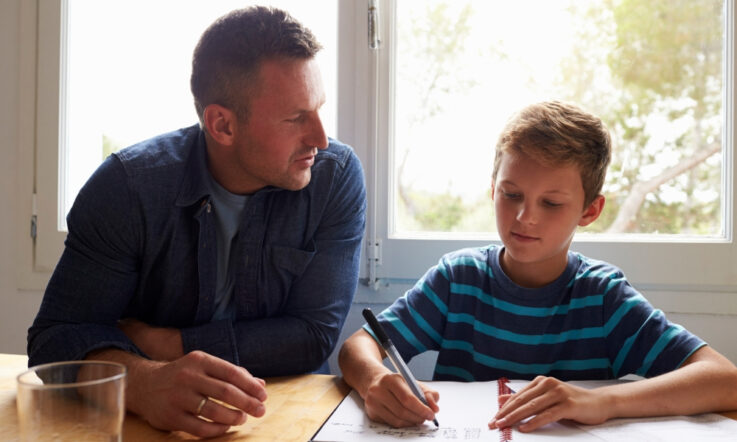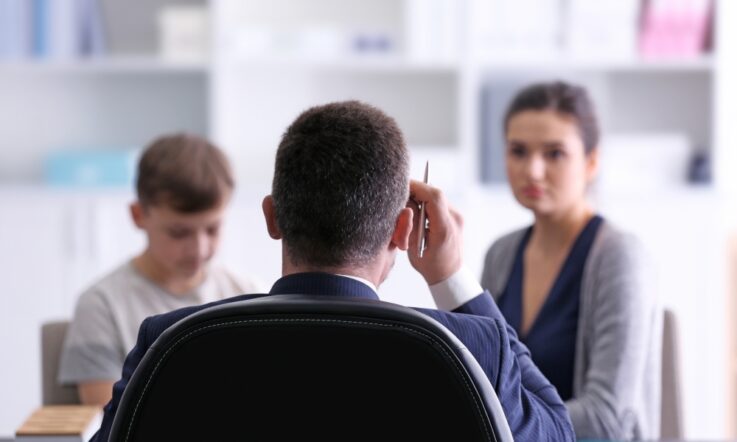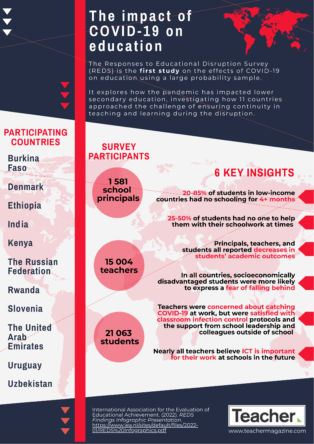This podcast from Teacher is supported by Bank First – the bank that exists to serve the education community. Visit bankfirst.com.au to find out how they can help you to reach your financial goals.
Hello, I’m Jo Earp and welcome to another Teacher podcast – Episode 39 in our series on School Improvement. My guest is Professor Pauline Taylor-Guy, Director of the ACER Institute and the Centre for School and System Improvement. Now, it’s almost two years to the day since I caught up with Pauline for a podcast special where we talked about how schools had adapted to emergency remote teaching following the first COVID lockdown. As she travels across Australia working with educators and systems, I thought I’d check in with her again to see how things have changed for schools and what the priorities are now for teachers, principals and communities on the ground. So let’s get started.
Jo Earp: Professor Pauline Taylor-Guy, thanks for joining me. Now, as I mentioned in the intro there, it's almost two years actually, exactly, to the day since our last podcast and a lot has happened since then, so I'm looking forward to catching up with you today. So first off, then, schools should have, they should have, a strategic plan in place and just to explain to people, if you're not a school leader that will have lots of key priorities in there for school improvement. So, there might be something, a specific goal around literacy for example, or professional development.
You work with schools across the country. How has the pandemic impacted those strategic plans and the targets that leaders had for improvement?
Pauline Taylor-Guy: Well, it's an interesting question, Jo, and thanks for the opportunity to be able to reflect a bit back on the last two years. I think, actually, what we're seeing perhaps surprisingly is a sharper focus on the part of schools and systems on their improvement agenda.
I think historically there's been a tendency to try and focus on everything in a strategic plan. So, this is what Michael Fullan talks about, about ‘fat plans’ (Fullan, 2009). You know, schools have these fat plans that are packed full of all these different things. Well we know that what's more effective is to have skinny plans where you focus just on a few priorities.
So I think the pandemic has really forced schools to focus on ‘keeping the main thing, the main thing’, and I borrowed those words from Helen Timperley (Timperley et al., 2020,), but we like those. Where it's that kind of laser-like focus on the kinds of strategies for improvement. So I really think that schools have got better at sharpening their focus over the period of the pandemic. That's what we're seeing.
JE: That's interesting because yeah, I’d not thought about that actually, but when you forced to do it and think, OK, we can't do everything, you know, needs must – like you say, you kind of have a different focus. That's really interesting actually that it's caused that. So earlier this year in Episode 37 of our School Improvement podcast (that's in March if listeners want to look that one up) I spoke to Judith Weir who is Principal of Our Lady of Mercy College - that's OLMC Heidelberg – about balancing competing priorities in terms of leadership and strategic planning and she raised two particularly interesting points in that, that I wanted to talk to you about. So, the first is the increased importance of student wellbeing.
PTG: Yeah. So, student wellbeing is interesting because student wellbeing more than ever is now recognised as a key factor in education in post-[COVID] or living in the COVID world.
I suppose, notably, wellbeing has always been in the National School Improvement Tool (Masters, 2016) and therefore in the evidence, the importance of wellbeing has always been there and the relationship between wellbeing and engagement and academic outcomes. But, more recently, there's been additional empirical research conducted into that relationship – the strong relationship between wellbeing and engagement, and academic achievement.
Those studies include: A systematic review of evidence (the first of its kind actually) that links student wellbeing and academic achievement (Dix, et al., 2020), and this study was conducted by ACER’s Katherine Dix and colleagues, and commissioned by Evidence for Learning and Victoria Health. And that systematic review just maps out the evidence that really relates the relationship very closely between wellbeing and engagement and learning, academic achievement.
So, we know how important it is. And actually we're doing a piece of work (just finished at the moment) where we’ve been involved in developing elaborations of the National School Improvement Tool as they relate to student wellbeing and engagement, because we’re recognising just how important wellbeing and engagement is. So these elaborations are really a deeper dive into the evidence that sits in those nine domains of the National School Improvement Tool.
And the purpose is, it's a resource, that these elaborations are a resource, to help guide good practice in school. So a deeper dive into the evidence around wellbeing to really articulate those into impactful practices for schools. And this is an initiative in partnership with the Queensland Department of Education and meets a clearly identified need in schools.
So, I think wellbeing has really come into sharp relief over COVID, but it was actually already there … the importance was already there, it’s just been called out.
And another study which I think has been really interesting is Jenny Gore and colleagues at the University of Newcastle (Gore et al., 2020). They did a study on the impacts of COVID on learning and that's really well worth a read. But that also basically confirms other studies which will say that, you know, most students’ learning wasn't overly impacted by COVID, unless they were disadvantaged students – and then they were exponentially impacted – but the issue of wellbeing has raised itself as being particularly important, and that relationship between wellbeing and learning.
Yeah, so I think it’s an increased focus, we’ve always known that, the evidence has said it but it’s just become much more evident, in our faces, since COVID.
JE: And, for listeners who are keen to look at those studies and take a read, I'll put the links as usual in the transcript to this podcast. Just head to teachermagazine.com and search for the School Improvement podcast and you can find the links there. The other point that Judith Weir mentioned in that podcast on school improvement from March was the impact of pandemic restrictions on staff. So, she was saying, you know, the workload, the fatigue, and that they really had to rethink how and also when they were doing the improvement work, just the sheer nature of being overwhelmed by this for staff.
PTG: So I don't think anyone would argue that teachers’ work hasn't intensified and become more complex during the pandemic. And we’ve seen the effects of teachers’ exhaustion, they're trying to juggle online, school closures, illness. And one of the things, you know, we're currently seeing is the impact of COVID in schools just in terms of being able to have teachers in front of classes as more people actually are becoming unwell and having to take time off.
But I do think that one of the things to understand around, you know, going back to that fat plan and skinny plan and laser-like focus keeping the main thing, the main thing is to understand that with a laser-like improvement focus, the improvement is embedded in everything that a school does. So I think that's also related to keeping the main thing the main thing.
And, you know, it's probably important to think about the ‘Outstanding’ performance levels in the nine domains of the NSIT. We talk about the high level of embeddedness of those improvement strategies. So, I think there's the dual thing. The one thing is just focusing on what's really important, so on a few strategic priorities. And the other one is trying to develop that embeddedness, so they become within the DNA of the school. So, they're not considered to be something additional or extra they're actually just things that teachers are doing as part of their day-to-day practice. It's not seen as something additional, it’s very embedded in their work.
JE: And again, if we go back to that point you were making, that first point about the fat plan and the skinny plan, you know, at schools they can't do everything at once. It's like changing something in your own classroom. This is long-term we're talking about, isn't it? This is long-term improvement journeys.
PTG: That's right. And I think that's … one of the things that schools tells us is one of the benefits of being able to, you know, engage with us in review services and really trying to hone in on those things that are going to have the most impact. Those kind of recommendations that we pull from a school review, those few things, those few strategic things that are really going to be first and foremost in improvement efforts.
And I think, you know, schools, as I've said before, you know the fat plan is the temptation to put everything in a strategic plan that you're wanting to do rather than just have that laser-like focus. We have a lovely metaphor that comes from the literature, which is to say, you know, school improvement has been characterised as a kitchen sink approach where you throw everything in and hope that if you swill it around something will come out of it. Or a scattergun approach, where you just try everything and hope that something sticks and has an impact.
And what we really trying to work towards is that really sharp laser-like focus of the things that are really going to make a difference. And not being distracted I guess about (and sometimes that's quite hard, you know), not being distracted by things, but really trying to keep, as I say, the main thing, the main thing.
JE: Yeah, help with the teacher workload and the wellbeing of the teachers as well.
We’ll bring you more of my chat with Professor Pauline Taylor-Guy after this quick message from our sponsor.
You’re listening to a podcast from Teacher magazine, supported by Bank First. Bank First is proud to be the bank that supports your purpose. They’ve been financially empowering educators to realise their dreams since 1972, and understand that your passion, dedication and expertise make a real difference to people’s lives. Visit bankfirst.com.au to find out how they can help you to reach your financial goals.
JE: So, I'm going to play a snippet from our podcast now, from a couple of years ago, and we'll be back in a moment.
‘Although this has been a very difficult situation, there are great benefits in it. For example, the possibility of schools networking with each other to offer particular subjects for example, and understanding that a school day doesn't necessarily have to be from 9am-3pm, that you could have some flexibility in the school day.
‘So these are all things that teachers and we know schools are kind of considering. There was a lovely example from one of the systems we're working with where they're saying: “Well, we've turned off all of these things. Which things are we going to turn on now and why?” That's part of system reflection as well as school reflection – things that have worked really well.
‘I certainly think that some of the collaboration that's happened within schools and across schools has been really beneficial, and people are already thinking about ways in which they could use the learning that they've had in recent, turbulent weeks to be able to plan for their students better, and have better infrastructure, maybe, and better skills in their teachers to be able to offer a curriculum more flexibly.’
JE: So, I wanted to return to that two years on then. As you get back into schools as I say you traveling across Australia now working with school leaders and teachers, what's changed for them in terms of the way they're working now. And particularly, that phrase, you know ‘what are we going to switch off and what we're going to turn back on again and why?’
PTG: Well, I think just at this particular point in time, schools are really experiencing the effect of another wave of COVID just on staff being able to be in schools at the moment. You know, we've seen a lot of schools with a large amount of staff actually absent because of illness.
But where we can see potential, I suppose, is again relating back to where schools are being more deliberate in their focus about learning and progress. So, one of those things, and I think you know teachers were catapulted into using various different technologies for learning. You know, sometimes, you know, not having any experience at that and trying to capitalise on some of those things. So we're seeing probably a forced use of technology as having benefits for schools as well about how students might engage with different kinds of learning platforms, for example, to be able to provide different ways than just face-to-face for learning. So I think that's something really important.
I think what we're seeing evidence of as well is that as I say really trying to focus on the most important things. So, perhaps you know the main focus of learning, really thinking about learning progress. I think teachers were, because of lockdowns and perhaps doing remote teaching, could become very focused on individual learning progress in a way that might get a little bit lost in a face-to-face classroom. So we're seeing some evidence of that.
In some of the schools that we work with, certainly some of the independent schools, for example, and those who are in more remote areas – ways of sharing resources, to be able to use technology to teach classes and broaden the curriculum. So, you know, teachers teaching out-of-field or a shortage of teachers in particular areas, people have thought a little bit differently about how they might collaborate with other schools and within networks to still offer a curriculum, but in a more flexible way, particularly in the upper grades of school where they might not have been able to do that before. So, we’re seeing some of that too.
JE: And just going back to that collaboration aspect, then, we talked about that in other podcasts and articles and many things that we've done at Teacher that you know all this expertise exists, within a school and across schools as well. But we kind of tend to keep it to ourselves because we just get on with our own jobs sometimes because we're so flat out that, you know, that's all we can see in front of us. And is, is that what you are finding that, you know, because things were stressed to such a point that, you know, we could no longer just do everything ourselves.
We had to think ‘Oh, I've got people around me actually that can help with this’. And that's improved collaboration within schools but also across schools and with school leaders. Is that something again that you're seeing – within schools collaboration?
PTG: Yeah, I think we are seeing some evidence of that, but also mindful that at the moment, sometimes it's just a question of having enough teachers in front of classes to be able to run programs at the moment. But we are certainly seeing evidence of that, and not just around teaching, but also around perhaps some of the services.
We've gone from, in our in our own lives, going from visiting a GP to telehealth, for example. And the opportunities that provides potentially to bring services into a community, particularly if they're a more remote community, in ways that they might not have considered before because that's become normalised through COVID.
Telehealth is one thing, but if you think about those kind of wraparound services for schools, that no longer is geography considered to be the only way of getting those services into schools to be able to support students and teachers. So we're seeing a little bit more of that, more imagination around that, perhaps more flexibility around that because of … just like we've seen in our health service, more flexibility in that because that's the only way we can actually deliver those services. So I think a there's been more imagination around that to be able to help with schools.
JE: But from what you've been saying, today, certainly the pressure is just still on very much for a lot of schools out there and it’s going to be a bit of a mixed picture in terms of who's being hit by the latest waves, and then obviously that causes staffing shortages. So, we shouldn't expect too much then (that's what I'm thinking) from the next few months?
PTG: Yeah, that's right. I think it's just everyone trying to keep their heads above water again. Just when we think that we've sort of ridden one wave fairly successfully, then we get hit with another one, I think. So we're just in that particular environment at the moment. And I do think just the length of time that this has gone on, that just contributes to kind of fatigue and exhaustion.
But I'm still super impressed – every time we go and work with systems in schools – about the enthusiasm (we're working with a number of new systems this year), the enthusiasm that people bring to this is, well, quite amazing really. You know, teachers and schools, school principals, are a very resilient bunch, you know, passionate about learning; so we see that too.
JE: Yeah. Unbelievable resilience from the education sector over the last couple of years, and always has been actually. So really that, that brings me to my final point then about the research side of things – there's probably going to be so much we don't know in terms of the impact and that's going to be ongoing. But, what do we know from some of the research that's already taken [place] about the impact of the pandemic on school staff, but also on students as well?
PTG: Yes, I mentioned before, Jenny Gore and colleagues’ work from the University of Newcastle. I mean, I think one of the things around COVID was that people were kind of predicting and trying to link previous kind of situations to the pandemic. And it's been interesting now to see perhaps more rigorous empirical research come out to see what the actual impacts have been.
Some of the work we've done at ACER, we've been involved in many studies about what the likely thing would be to happen. We’ve done some reports for government. We did an evidence-based framework very early on in the piece for schools to be able to respond to remote teaching situations. And we've also produced policy frameworks, but internationally, to be able to respond, to think about different areas of response in medium, low and actually no-tech environments.
So, I think what we're going to see now and what's going to be really important is those really strong empirical studies that show particular impacts in particular contexts. And there are a number of those that are emerging, as I say, in Australia now and just researching this.
And also, you know, we don't have an awful lot of evidence around the impact on wellbeing, like the long-term impacts of wellbeing, or even about school engagement or attendance at school. We don't have that evidence yet – because there was concern that during school closures etcetera, some students disappear and then they never reengage with education again.
But I must say that education systems have been very diligent around trying to reengage and have strategies to reengage hard to reach students and families where that has occurred. So, that was part of the impetus, I think, to do the elaborations of the NSIT (the in-depth project with Queensland) and we're getting a lot of interest about that from different jurisdictions across Australia.
JE: So there's plenty of research to come on this and the impact. Well, it's been fascinating catching up with you today again, Professor Pauline Taylor-Guy (it's always great to catch up with you, I'm hoping that we don't leave it until 2024, May 2024 if we go by our timetable that we've had so far!). Best of luck with the work that you're doing, and thanks again for joining us at Teacher.
That’s all for this episode – if you want to keep listening, you can access the 200+ episodes already in our archive. If you haven’t already, be sure to subscribe to our podcast channel on Spotify, Apple podcasts, SoundCloud, or wherever you get your podcasts from, so you can keep up to date with our latest episodes. And, while you’re there, we’d love it if you could rate and review us.
You’ve been listening to a podcast from Teacher, supported by Bank First – the bank that exists to serve the education community. Visit bankfirst.com.au to find out how they can help you to reach your financial goals.
References and further reading
Dix, K., Ahmed, S. K., Carslake, T., Sniedze-Gregory, S., O’Grady, E., & Trevitt, J. (2020). Student health and wellbeing: A systematic review of intervention research examining effective student wellbeing in schools and their academic outcomes. Main report and executive summary. Evidence for Learning. https://research.acer.edu.au/w...
Fullan, M. (2009). Motion Leadership: The Skinny on Becoming Change Savvy. Corwin.
Gore, J., Fray, L., Miller, D., Harris, J., & Taggart, W. (December 2020). Report to the NSW Department of Education. Evaluating the impact of COVID-19 on NSW Schools. University of Newcastle. https://www.newcastle.edu.au/__data/assets/pdf_file/0008/704924/Evaluating-the-impact-of-COVID-19-on-NSW-schools.pdf (PDF, 1.45MB)
Masters, G. N. (2016). National School Improvement Tool. ACER. https://research.acer.edu.au/tll_misc/18 (PDF, 260KB)
Timperley, H., Ell, F., Le Fevre, D., & Twyford, K. (2020). Leading Professional Learning. ACER. https://shop.acer.org/teaching-practice/leading-professional-learning.html
As a school leader, how have your improvement priorities changed over the last two years?
Do you have a clear, narrow focus in your own strategic planning? What is the ‘main thing’ and how do you ensure that this remains the ‘main thing’ for you, your leadership team and staff?



